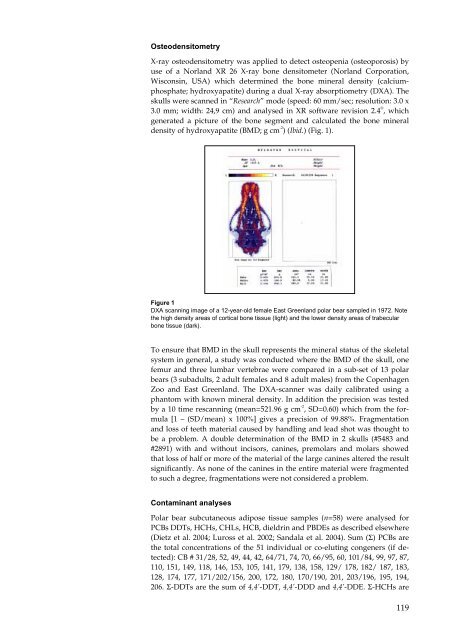Organohalogen concentrations and a gross and histologic ...
Organohalogen concentrations and a gross and histologic ...
Organohalogen concentrations and a gross and histologic ...
Create successful ePaper yourself
Turn your PDF publications into a flip-book with our unique Google optimized e-Paper software.
Osteodensitometry<br />
X-ray osteodensitometry was applied to detect osteopenia (osteoporosis) by<br />
use of a Norl<strong>and</strong> XR 26 X-ray bone densitometer (Norl<strong>and</strong> Corporation,<br />
Wisconsin, USA) which determined the bone mineral density (calciumphosphate;<br />
hydroxyapatite) during a dual X-ray absorptiometry (DXA). The<br />
skulls were scanned in “Research” mode (speed: 60 mm/sec; resolution: 3.0 x<br />
3.0 mm; width: 24,9 cm) <strong>and</strong> analysed in XR software revision 2.4 ® , which<br />
generated a picture of the bone segment <strong>and</strong> calculated the bone mineral<br />
density of hydroxyapatite (BMD; g cm -2 ) (Ibid.) (Fig. 1).<br />
Figure 1<br />
DXA scanning image of a 12-year-old female East Greenl<strong>and</strong> polar bear sampled in 1972. Note<br />
the high density areas of cortical bone tissue (light) <strong>and</strong> the lower density areas of trabecular<br />
bone tissue (dark).<br />
To ensure that BMD in the skull represents the mineral status of the skeletal<br />
system in general, a study was conducted where the BMD of the skull, one<br />
femur <strong>and</strong> three lumbar vertebrae were compared in a sub-set of 13 polar<br />
bears (3 subadults, 2 adult females <strong>and</strong> 8 adult males) from the Copenhagen<br />
Zoo <strong>and</strong> East Greenl<strong>and</strong>. The DXA-scanner was daily calibrated using a<br />
phantom with known mineral density. In addition the precision was tested<br />
by a 10 time rescanning (mean=521.96 g cm -2<br />
, SD=0.60) which from the formula<br />
[1 – (SD/mean) x 100%] gives a precision of 99.88%. Fragmentation<br />
<strong>and</strong> loss of teeth material caused by h<strong>and</strong>ling <strong>and</strong> lead shot was thought to<br />
be a problem. A double determination of the BMD in 2 skulls (#5483 <strong>and</strong><br />
#2891) with <strong>and</strong> without incisors, canines, premolars <strong>and</strong> molars showed<br />
that loss of half or more of the material of the large canines altered the result<br />
significantly. As none of the canines in the entire material were fragmented<br />
to such a degree, fragmentations were not considered a problem.<br />
Contaminant analyses<br />
Polar bear subcutaneous adipose tissue samples (n=58) were analysed for<br />
PCBs DDTs, HCHs, CHLs, HCB, dieldrin <strong>and</strong> PBDEs as described elsewhere<br />
(Dietz et al. 2004; Luross et al. 2002; S<strong>and</strong>ala et al. 2004). Sum (Σ) PCBs are<br />
the total <strong>concentrations</strong> of the 51 individual or co-eluting congeners (if detected):<br />
CB # 31/28, 52, 49, 44, 42, 64/71, 74, 70, 66/95, 60, 101/84, 99, 97, 87,<br />
110, 151, 149, 118, 146, 153, 105, 141, 179, 138, 158, 129/ 178, 182/ 187, 183,<br />
128, 174, 177, 171/202/156, 200, 172, 180, 170/190, 201, 203/196, 195, 194,<br />
206. Σ-DDTs are the sum of 4,4’-DDT, 4,4’-DDD <strong>and</strong> 4,4’-DDE. Σ-HCHs are<br />
119

















